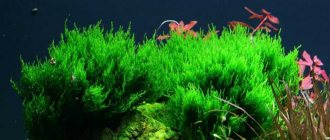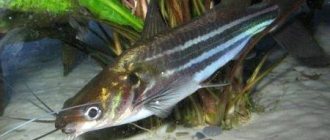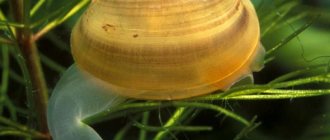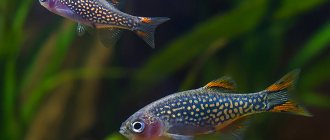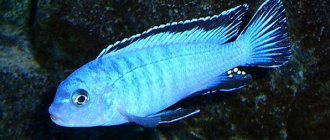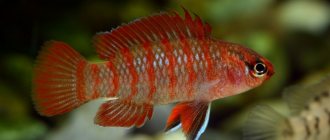No special care is required to maintain Lomariopsis lineata, however, the most favorable conditions exist for cultivating the plant: carbonate water hardness - from two to seventeen degrees, pH level - from six to eight, water temperature - from eighteen to twenty-eight degrees Celsius. Lighting should be intense, diffused, emphasizes uwwportal.ru. With undispersed, excessive lighting, the leaves of Lomariopsis lineata become noticeably smaller. You should choose fluorescent lamps with a power of 0.25 - 0.4 W/l as illuminators. Natural light is very beneficial for the plant.
Lomariopsis lineata can be kept with other shade-loving aquarium plants. Lomariopsis lineata is heavier than water, so to participate in aquatic design, you simply need to attach the plant to the substrate. If the Lomariopsis lineata group grows greatly, then it is divided and the excess shoots are used for new aquarium compositions. Lomariopsis looks very beautiful in an aquarium - it is one of the most spectacular natural materials used for decorating an aquarium.
The growth rate of Lomariopsis lineata is not high. When Lomariopsis lineata grows, it forms bright green hummocks about five centimeters high, in which shy aquarium fish, shrimp and fry hide. A delicate plant of the Lomariopsis family is used as food by some representatives of the aquarium fauna, so large fish and voracious cichlids should not be placed in an aquarium with Lomariopsis. In an aquarium, the plant is placed in the background or in the center.
Lomariopsis lineata, with the help of rhizoids, is securely attached to the substrate, so when transplanted to a new place, it is tied to the decorations, and after three to four weeks, it “grows” into the porous surface. If you decide to cultivate Lomariopsis in your aquarium, then be patient - it will take some time for Lomariopsis lineata to show itself in all its glory. The plant can grow in one place for a long time without requiring replanting, and you will not see rot or dying shoots.
Lomariopsis lineata contents care description reproduction.
No special care is required to maintain Lomariopsis lineata, however, the most favorable conditions exist for cultivating the plant: carbonate water hardness - from two to seventeen degrees, pH level - from six to eight, water temperature - from eighteen to twenty-eight degrees Celsius.
Lighting should be intense, diffused, emphasizes uwwportal.ru. With undispersed, excessive lighting, the leaves of Lomariopsis lineata become noticeably smaller. You should choose fluorescent lamps with a power of 0.25 - 0.4 W/l as illuminators. Natural light is very beneficial for the plant. Lomariopsis lineata can be kept with other shade-loving aquarium plants. Lomariopsis lineata is heavier than water, so to participate in aquatic design, you simply need to attach the plant to the substrate. If the Lomariopsis lineata group grows greatly, then it is divided and the excess shoots are used for new aquarium compositions. Lomariopsis looks very beautiful in an aquarium - it is one of the most spectacular natural materials used for decorating an aquarium.
The growth rate of Lomariopsis lineata is not high. When Lomariopsis lineata grows, it forms bright green hummocks about five centimeters high, in which shy aquarium fish, shrimp and fry hide. A delicate plant of the Lomariopsis family is used as food by some representatives of the aquarium fauna, so large fish and voracious cichlids should not be placed in an aquarium with Lomariopsis. In an aquarium, the plant is placed in the background or in the center.
Lomariopsis lineata, with the help of rhizoids, is securely attached to the substrate, so when transplanted to a new place, it is tied to the decorations, and after three to four weeks, it “grows” into the porous surface. If you decide to cultivate Lomariopsis in your aquarium, then be patient - it will take some time for Lomariopsis lineata to show itself in all its glory. The plant can grow in one place for a long time without requiring replanting, and you will not see rot or dying shoots.
Necessary conditions for cultivation.
Water temperature from 18 to 20°C; Water hardness dH from 2-30°dGH; Acid-base composition of water pH from six and a half to eight; The softer the water, the faster the plant grows. Feeding with fertilizers is not necessary, but it is advisable to feed with carbon dioxide. Lighting from three-tenths to four-tenths of watts per liter will be sufficient.
Direct sunlight should not fall on the leaves; the plant stops growing and becomes dark green in color. A dark place is favorable for the growth of lineata; it can be planted in an aquarium both in the foreground and in the background. Lomariopsis does not float to the surface; initially it needs to be fixed in a certain place so that the plant takes root, then there is no need for additional care.
When the bush grows, it can be divided into parts and planted, the seedlings take root and continue to grow. Lomariopsis can be propagated either by dividing the bush or by spores. One spore produces one shoot, which over time turns into a heart-shaped prothallium. At this moment, it is still an inferior bush, but a teenager from which over time will grow into a real bush. This is how Lomariopsis lineata reproduces.
What conditions will be required?
Our member of the Lomariopsis family is easy to keep, so even novice aquarists can grow it. Let's note some features of care:
- The size of the aquarium does not matter. Can be kept in both miniature and giant containers.
- Optimal characteristics for water: temperature range from 18 to 30 °C, hardness not less than 2 and not more than 30 °dH, acidity within 6.5-8.0 pH. Growth in soft water is more intense. It is advisable to add additional CO2. Mineral fertilizers are not needed.
- Recommended lighting 0.3-0.4 W/l. If you increase it or increase the duration of exposure to direct sunlight, the fern slows down its growth even more, its foliage darkens and becomes smaller. But this plant tolerates low light well and survives where others die.
- Lomariopsis lineata is characterized by slow growth. The disadvantage of this is that you will not see it in all its glory immediately, but after a long time. Pros - you don’t need to replant often, the lower part doesn’t rot or die.
Description
The distribution area of Lomariopsis lineata is Australia, China, Malaysia.
In its natural environment, fern can grow both in bodies of water at different depths and with slow currents, and in wet areas of land. Lomariopsis lineata is a form of land fern that develops from spores and produces gametes (sex cells). You can find information that this is a false fern. This is due to the fact that the plant does not always become a gametophyte - the adult form of ferns, but remains a prothallus. But this issue remains controversial to this day.
Lomariopsis is often confused with liver moss monosolenium tenerum or pellia. But experts find characteristic differences in them, which lie in the shape of the leaves. In Lomariopsis they are more rounded, openwork and do not have a central vein. The leaves are thinner and almost transparent green.
Look at Lomariopsis lineata in an aquarium:
This is a plant that tends to grow upward, as if adjusting the floors. While monosolenium is not “multi-story” and grows in a horizontal plane. The maximum size of Lomariopsis in nature and an aquarium is 20 cm. But on average, the size of a bush in an artificial biosystem is 10 cm in height and width. Therefore, the shape of the fern is similar to a ball.
Lomariopsis lineata in nature
The natural habitat of the fern is China, Malaysia, the Philippines, New Guinea, Australia, America, and Africa. Beautiful green bushes were found in reservoirs with fresh, clean, slow-flowing water.
Russian aquarists became acquainted with this representative of the Lomariopsis genus relatively recently - in 2008. Since that time, the popularity of the plant has increased many times, and it has become widespread due to its beauty and unpretentiousness.
Features of maintenance and care
Lomariopsis lineata loves flow. Therefore, the best place for it in the aquarium will be the area next to the water pump, where it is attached to suction cups for better fixation. Compliance with this maintenance condition will not allow organic deposits and suspensions rising from the soil surface to settle on the leaves, which is why the plant develops better.
The fern can do without mineral supplements, taking everything it needs from the water, but it responds to fertilizing with fertilizers and the supply of carbon dioxide with noticeable growth and bright color.
The representative of Lomariopsis easily tolerates shading and feels great on the bottom, fenced off from the light by other tall plants. It can survive in very low light, which is destructive for other hydrophytes, and will not even stop in its development. Strong lighting does not have a beneficial effect on the plant. In intense light, the color of the bush becomes dark green and the leaves become smaller. Ferns suffer especially badly when exposed to direct sunlight. The optimal lamp power for Lomariopsis lineata is 0.3-0.4 W/l.
Hydrochemical content parameters:
- Lomariopsis prefers soft water, because its growth becomes slower in hard water.
- The most suitable pH level is in the range of 6.0-7.5. Indicators below 5.0 and above 8.0 are not compatible with the normal functioning of the fern.
- The temperature scale is wide: from 18 to 30ºС. But the 30ºС mark is the maximum threshold at which the fern retains its viability. The lower limit is 15ºС. The optimal temperature is 22-28ºС.
Soil is not important for Lomariopsis, since it absorbs all nutrients from water.
Due to the density of the thickets, the fern is an excellent pasture for shrimp and a refuge for fry of viviparous fish. Shrimp, like snails, do not damage the plant, but clean it of organic deposits, so in such a neighborhood the appearance of the fern is always well-groomed. But you should avoid introducing large predators, such as cichlids. They are able to eat a tender plant completely.
Algal fouling poses a danger to Lomariopsis. They are eliminated mechanically or using chemicals. To get rid of filaments, it is enough to rinse the fern under running water. Another method is to plant the bush in a separate container and shade it for three days. When using chemicals, keep in mind that the plant does not tolerate hydrogen peroxide and may wither.
Diseases
The plant does not suffer from diseases, but a problem may arise with algae attached to it, which will reduce the decorative value of Lomariopsis due to parasitism on it.
The easiest way to get rid of this problem is to periodically wash the moss in running water, removing the algae yourself. Experts do not recommend using hydrogen peroxide.
Some aquarists get rid of parasites by using microscopic crustaceans - ostracods. But you should know that they reproduce very quickly, so you can breed them only if there are fish in your home pond that feed on these crustaceans.
Reproduction in an aquarium
Reproduction of Lomariopsis lineata in an aquarium occurs by simply dividing the bush. Even a small part of it can begin to grow anywhere in the aquarium and form a lush thicket. Lomariopsis lineata grows continuously underwater due to continuous cell division.
They begin to plant the mother bush when the fern reaches 10 cm in height.
But the new shoots will not immediately begin to grow. A certain amount of time must pass, which may take several weeks, for the plant to begin to increase in volume.
When propagated by spores, a sprout appears from the cell, which transforms into a teenager, shaped like a heart, and then a new bush develops.
Other ferns in the aquarium:
What does it look like
The appearance of this plant is quite unusual and decorative. The fern is somewhat reminiscent of seaweed. The shape of Lomariopsis is spherical, and its dimensions in an aquarium reach 10 by 10 cm, in the natural environment - 20 by 20 cm.
Lineata grows very slowly, gradually taking on the appearance of lush, beautiful green mounds. The leaves and roots of the fern do not rot.
Decorative qualities of fern
Lomariopsis is endowed with rhizoids, with which it grows to the substrate at a fairly low speed. Stones, lava, driftwood and other decorations are used as a base for fastening. Ferns are tied to them with threads, fishing lines, and placed on suction cups. The fern tied to the base begins to grow better and gradually grows to the surface. Aquarists do not recommend using cotton threads, as they rot and Lomariopsis lineata can tear away from the substrate before it has time to grow. This method of decoration allows you to transfer decorations covered with lomariopsis to any place in the tank.
Lomariopsis is a fairly heavy plant. It does not float to the surface, for this reason it is either simply placed on the ground or tied to a stone. After a few weeks, the plant covers the base with a dense carpet, forming beautiful mounds. Only in places where the current is strong enough is the fern strengthened in the ground so that it is not carried to another place.
Just like mosses, ferns are placed under a net to create a green field at the bottom of the aquarium or a background on the back wall.
Lomariopsis can grow in one place for a long time without requiring replanting. Moreover, its lower leaves, even with a lack of light and when growing into a thick layer, do not turn black and do not die. It is for this quality that ferns are valued by aquarists. Over time, if the bush grows too much, it is divided into parts and replanted.
The fern does well just floating in the water without rooting. He is able to stay in one place for a long time. But water changes and currents created by the filtration system make it drift around the aquarium, which also brings originality to aquadesign.
The plant develops upward, so it looks advantageous in combination with mosses, which, with rare exceptions, for example, flame moss, grow in width.
The fern demonstrates its decorative qualities equally well on all three levels of the aquarium and in any biotope. Also suitable for nano aquariums and will not get lost in very large containers.
The unpretentiousness, brightness, and compactness of Lomariopsis contribute to the fact that beginners and experienced aquarists choose the fern as a decoration for their aquarium.
Properties and Features
Lomariopsis lineata belongs to ferns , being their photosynthetic form. In reality, this means that it is capable of releasing oxygen when exposed to light.
This type of aquarium plant is known for its unpretentiousness and ease of care. It can grow on any surface in aquariums of any size. Its leaves never die and are constantly in the process of growing.
Sometimes it is mistaken for liver moss, but this variety of aquarium plants is significantly inferior to lomariopsis both in appearance and in terms of care requirements.
Use in aquarium decoration
Lomariopsis is a really good plant for decorating an aquarium. It is very convenient to use and easy to maintain.
- Thanks to its shade-loving nature, this is an excellent “background” plant that can be placed against the back wall, in the shade of large leaves.
- Hemaphyte is ideally combined in appearance and maintenance conditions with other types of ferns and mosses. It feels especially good if liver moss grows nearby.
- The plant is a real find for miniature aquariums. Medium-sized leaves and small picturesque clumps fit perfectly into the scale of mini-reservoirs.
- Unlike many other plants, this fern is not damaged by snails and shrimp, so it is well suited for aquariums with these species of inhabitants. Aquatic pets actively clean the leaves of the fern without touching the plant itself, so it always looks well-groomed and aesthetically pleasing.
- The plant has a vertical thallus - it develops upward, looking beautiful against the background of horizontal mosses, which grow mainly in width. At the same time, the lower part of the curtain remains alive for a long time, does not rot and does not require renewal, like many other plants.
This small fern seems, at first glance, inconspicuous, but it is the one that has the necessary versatility and all the qualities necessary for a spectacular, complete aquarium design. Endurance and simple maintenance are another of the undeniable advantages of such a green pet.
Return to content
Features of keeping in an aquarium
This variety of aquarium ferns is very easy to care for. To make the plant comfortable, it is important to adhere to the following recommendations.
The water should be of medium hardness. The recommended hardness level is 6.0-8.0 °dH. Harder water slows down the growth of Lomariopsis, and softening, on the contrary, causes increased growth.
The temperature range is quite wide - from +18 to +30 °C. The plant tolerates sudden changes in temperature well, but prolonged exposure to temperatures below +15 °C can significantly slow down its growth and spoil its decorative appearance.
Due to the fact that Lomariopsis lineata takes all the substances necessary for its development from water, special attention should be paid to the quality and mandatory filtration of water.
Priming
Lomariopsis grows well both in the ground and on any surface - stones, driftwood and other decorative elements in the aquarium.
Lighting
Lomariopsis does not require bright lighting for its maintenance. It is enough to maintain the illumination of the aquarium at around 0.3-0.4 W/l. Increased brightness can lead to a change in the color of its leaves - they acquire a dark green, emerald hue.
Aquarium design
Lomariopsis moss is often used to decorate home ponds of all types and sizes, including “Dutch” and “nano”. It looks best in the middle or background. If desired, it is permissible to grow in the foreground.
Many novice aquarists are wondering how to attach Lomariopsis moss? This is done using nylon threads, and it is tied to stones, driftwood and any other decorative elements.
The fern grows very well, does not float up, and over time turns into lush green mounds in which shrimp, fish fry and other small animals hide.
In addition, with the help of lomariopsis moss you can create a green meadow. To do this, a thallus is placed on the bottom, and a mesh is placed on top of it. After some time, the fern will grow and the net will not be visible.
It must be taken into account that this plant is shade-loving, so other inhabitants of the aquarium must be matched to it so that Lomariopsis does not suffer from an excess or lack of light.
You should also avoid voracious and large herbivorous fish, such as cichlids, which easily and quickly eat it to the very root.
Care instructions
Lomaripsis lineata is an unpretentious plant. To create comfortable living conditions, it is enough to maintain optimal water and air temperatures. Creating shady areas in the aquarium will have a positive effect on the growth and color saturation of the leaves.
Also, the aquarium fern likes to be close to the movement of water, because of this its smoothly writhing wavy leaves will have a very beautiful and decorative appearance. Additional introduction of fertilizing is not required.
Planting and propagation
Planting Lomariopsis in an aquarium is a very easy process that even a beginner in aquarium farming can handle. Now you can see this for yourself.
These algae do not have a root system; they adhere to the walls of the aquarium with the help of rhizoids - microscopic single-celled hairs that reliably stick to any surface. To plant the bush, carefully tie it to a piece of driftwood, rock or other object in the aquarium. After some time, the rhizoids will anchor the fern in place.
Most often, experienced aquarists recommend dividing the bush in two after its voluminous mound has grown to 10 cm. It reproduces in two ways:
- Bush division . This is the easiest and most accessible method for every aquarist - you divide the overgrown bush into two parts and plant it in the right places in your underwater world.
- Disputes. This method of propagation is available to ferns under natural conditions. This process takes some time and looks very curious - a shoot grows from the spore, which, in turn, releases prothallium in the shape of a heart. After some time, such a heart begins to transform into the wavy leaves of the Lomariopsis lineata fern. Each segment of a new stage of growth of an underwater plant takes several weeks; in open reservoirs it grows much more slowly than in aquariums.
Care and breeding
After fixing the bush in the chosen place and then rooting it, you will have practically nothing else to do with it. The only thing is, if it grows too big, it can be divided into several parts and planted in different places.
The plant can reproduce in two ways:
- Disputes. From one spore a miniature sprout emerges, and from it a few weeks later a heart-shaped prothallium (this is not yet a full-fledged bush, but a teenager) and from it subsequently a new bush.
- Dividing the bush. Vegetative propagation is more often used in domestic reservoirs than the previous one. Ideally, the bush should look like a neat ball. If you see a large green cap in your aquarium, then it’s time to plant it. To do this, a large bush is carefully torn into pieces and placed in selected places.
So, to everyone who would like to transform their aquarium beyond recognition, add some zest to its design or develop a new plant, we recommend Lomariopsis lineata! Lush green mounds will not only decorate your underwater “kingdom”, but will also not require much effort to keep them in good shape. And it doesn’t matter whether you have a lot of experience or not at all, you can definitely handle it.
Fish compatibility
Comfortable conditions for lomariopsis require careful selection of neighbors. Not all aquarium inhabitants will like the lack of bright light. It is also not recommended for ferns and herbivorous fish, such as cichlids, to live together. Large fish will also not mind eating the plant.
As you can see, anyone can decorate their aquarium with large-leaved pellia. Lush green mounds at the bottom of the aquarium will help transform it beyond recognition. And the thick, long leaves can become an excellent refuge for your fish.
Sources:
https://aquarium-fish-home.ru/uncategorized/lomariopsis-lineata-soderzhanie-uxod-opisanie-razmnozhenie/.html https://vmirerybok.ru/lomariopsis-lineata-uxod-i-soderzhanie/ https:// pets2.me/bok/1098-pravila-po-uhodu-posadke-i-sovmestimosti-lomariopsisa-s-rybkami.html
